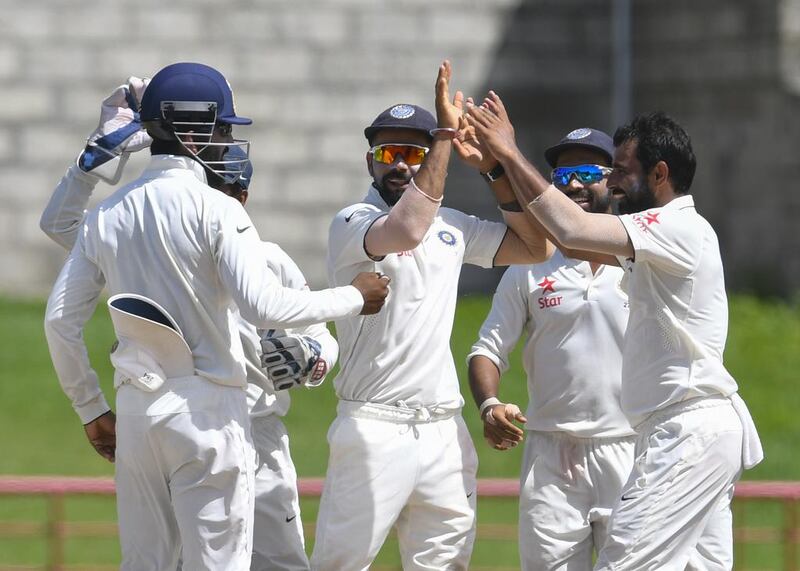These are good days for Indian cricket. The Test team, in disarray not long ago, are up to No 2 in the rankings after an emphatic series win in the Caribbean.
In the past four global limited-overs events, they have been by far the most consistent side, chalking up a victory (Champions Trophy 2013), a final appearance (World Twenty20 2014) and two semi-finals (World Cup 2015 and WT20 2016).
The Under-19s finished runners-up to West Indies earlier this year, and the “A” team, also coached by Rahul Dravid, won a quadrangular tournament in Australia just last week.
There is impressive strength in depth and real optimism about the immediate future under the new leadership combination of Virat Kohli and Anil Kumble.
Sadly, that fresh spring air does not extend to the administration of the sport.
• More: BCCI objections lead to ICC shelving two-tier Test plan
The Board of Control for Cricket in India (BCCI) has been pushed to the wall by the recommendations of the Supreme Court-appointed Lodha Committee.
If those have to be implemented in full or even in part, it will mark the end of many an ambitious administrative career.
And if domestic woes were not enough, the BCCI now faces a threat to its economic stranglehold on the game.
At the recent International Cricket Council (ICC) workshop in Dubai, there were two significant developments.
On the one hand, the BCCI, now led by Anurag Thakur, a Member of Parliament, came off looking like Robin Hood after ensuring that the reorganisation of Test cricket into two tiers would not happen.
Demotion into a second division would almost certainly have meant the death knell for the format in Zimbabwe and West Indies and a serious setback for Bangladesh, who now have a core group of players capable of pushing the elite.
Sri Lanka, who have struggled with transition despite the ease with which they brushed aside a desperately disappointing Australia, would also have been under threat.
As it is, thanks to poor administration and a lack of lucrative sponsors, cricket in Sri Lanka, West Indies and Zimbabwe depends heavily on ICC handouts.
The England and Wales Cricket Board (ECB), Cricket Australia (CA) and Cricket South Africa (CSA), once staunch BCCI allies, were all in favour of a two-tier system.
Pakistan, too, did not join the rest of the Asian Bloc in pushing for the status quo to be maintained. The ECB and CA were part of the Big Three with the BCCI not long ago, but that uneasy alliance now looks distinctly shaky.
CA and the ECB are also at the forefront of the collective bargaining for overseas TV rights. The money that boards earn from broadcast deals at home – the ECB with Sky and CA with Channel Nine – is supplemented by overseas sales.
Till now, there were three networks – Star Sports, Sony and Ten Sports – that picked up rights for series such as the Ashes and anything else not involving India.
Now, with Sony having bought Ten Sports for US$385 million (Dh1.4bn), there are only two options. With the surfeit of cricket on Indian television these days – even the Tamil Nadu Premier League is being aired live – there is very little appetite for overseas cricket outside of the Ashes.
Any future deals that CA or the ECB sign with Star Sports and Sony are unlikely to be anything like as lucrative as the current one.
And if that is their situation, you can imagine the portents for a South Africa or New Zealand.
Collective bargaining would allow cricket boards to bundle the rights together so that Star or Sony pay a consolidated sum for several series together instead of paying just one board.
The constituent boards would then divvy that amount up.
For more than a decade, Indian cricket has grown complacent about its position of dominance.
This jolt, along with the Lodha recommendations, will force it to look within and treat the game with more care.
There will need to be more innovation and imagination in promoting less high-profile series, and greater respect in dealing with other boards.
Given the handsome support it has given West Indies, Sri Lanka and Zimbabwe – even Bangladesh – in times of need, the BCCI’s support base within the ICC is not about to melt away any time soon.
But in the long run, a more equitable financial model, where it doesn’t have absolute power, could just be the push it needs to get its own house in order.
Paralympic success a true epic story
At the 2015 International Paralympic Committee (IPC) Athletics World Championships in Doha, Sam Grewe of the United States of America won the gold medal in the men’s high jump T42 (athletes with a single above-the-knee amputation or comparable disability) with a leap of 1.81 metres.
Egypt’s Hamada Hassan took silver with 1.78m.
On September 9, at Rio de Janeiro, Grewe smashed his personal best with 1.86m. Hassan had a jump of 1.74m to finish seventh. And Grewe didn’t claim Paralympic gold. That went to India’s Mariyappan Thangavelu, who improved on his qualification leap of 1.78m by a whopping 11cm. Varun Singh Bhati, his teammate, who jumped the same height as Grewe, took the bronze.
After widespread angst in the month of August, when India failed to win a single gold at the Olympic Games – PV Sindhu’s silver in the women’s badminton and Sakshi Malik’s wrestling bronze were the highlights – this double success by the nation’s Paralympic athletes has attracted nothing like the same attention.
Thangavelu’s is a story worthy of the silver screen. He was just five when a bus swerved off the road in his village of Periavadagampatti and crushed his right leg below the knee.
“I was told the driver was inebriated,” he told The Hindu in an interview earlier this year. “It doesn’t matter. My right leg is now stunted. It is still a five-year-old’s leg. It has never grown or healed.”
His mother took a loan of Ru300,000 to pay the medical bills and now sells vegetables to pay it off.
Thangavelu was a 14-year-old schoolboy when he first tried the high jump.
Competing against those with no physical impairments, he finished second. From that to Paralympic glory, it’s been an epic journey.
Most Indian stadiums do not have ramps for wheelchair access. Triumphs such as Thangavelu’s will hopefully change attitudes, especially in a country that has had so little to shout about in the sporting arena.
sports@thenational.ae
Follow us on Twitter @NatSportUAE
Like us on Facebook at facebook.com/TheNationalSport
* Editor's note: An earlier version of this story incorrectly stated the loan amount by Thangavelu's mother was Ru3million





